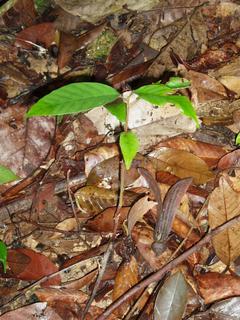What a name to restart this blog in 2008. My time is really ticking - no manuscript (yet) after almost one year of the completion of Big Tree survey - everything has been just ticking along slowly (ticking over). I need to find the very thing that makes me tick and be productive. The eleventh hour gets a tick for that but it is also unhealthy.
Anyway, productivity aside, I was really ticked off by the way the forest welcomed me back - its very own
TICKS, some 50 or so of them! These creatures, albeit tiny, gave me unforgettable love bites that make me wish that I can cut off my limbs! My body is so allergic to their saliva that I couldn't sleep for the past 10 days and need to be on both
anti-histamine and
steroid cream.
 two days after bite, not showing those on arm, tight, hip, and parts rather not mention here
two days after bite, not showing those on arm, tight, hip, and parts rather not mention here fourth day - one of the itchiest days (actually can't think of which day is not itchy)
fourth day - one of the itchiest days (actually can't think of which day is not itchy)
 day 11 - finally healing, with an accidental scratch scar
day 11 - finally healing, with an accidental scratch scarFortunately unlike ticks in the temperate, these tropical ticks are unlikely to be vectors of diseases (
e.g. Lyme disease). In every stage of their
lifecycle, they just climb up a stem/grass and wait to attach to a passing host, and a meal of fresh blood. The only way to avoid getting their painful (itchy) bites is to avoid physical contact with the shrubs they perched on, or wear pesticide-treated clothes (and get some chronic poisoning at the same time).
I guess the moral of the story is not to walk into the forest if you do not need to (this goes to everyone, whether or not your favorite activity has to do with some letters 'H'). Hopefully ticks do safeguard the seedlings from some human trampling.
Myth or Truth: some people believe that ticks deposit eggs under host's skin when they bite, and the larvae will chomp away tissue after they're hatched, hence the unbearable itch. Think about this - if the ticks are able to inject eggs via their mouthpart (hypostome), they must have had their organs growing in their face, and they must be doing only "oral" sex.
 Rengas' bark fissures like Seraya, but normally scattered with its infamous tell tale sign. Don't anyhow hug a "Seraya" if you are not sure what it is!
Rengas' bark fissures like Seraya, but normally scattered with its infamous tell tale sign. Don't anyhow hug a "Seraya" if you are not sure what it is!














